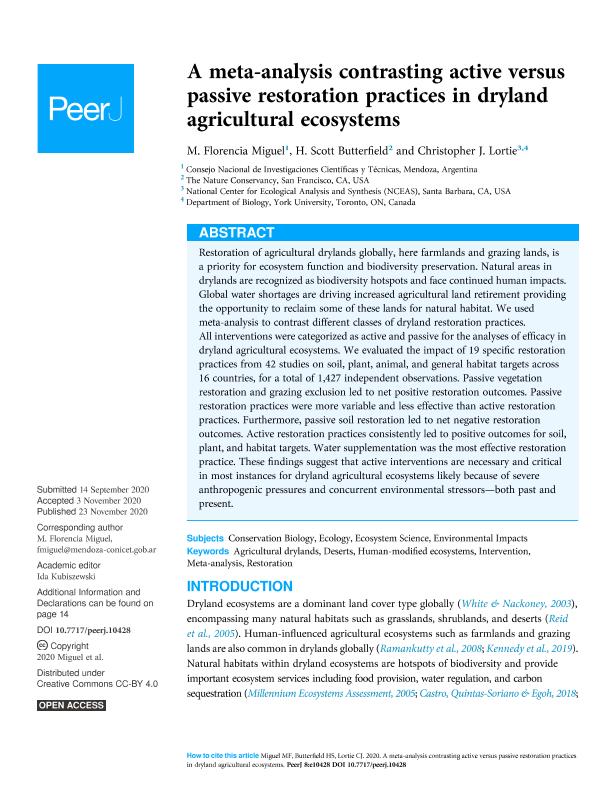Artículo
A meta-analysis contrasting active versus passive restoration practices in dryland agricultural ecosystems
Fecha de publicación:
11/2020
Editorial:
PeerJ Inc.
Revista:
PeerJ
e-ISSN:
2167-8359
Idioma:
Inglés
Tipo de recurso:
Artículo publicado
Clasificación temática:
Resumen
Restoration of agricultural drylands globally, here farmlands and grazing lands, is a priority for ecosystem function and biodiversity preservation. Natural areas in drylands are recognized as biodiversity hotspots and face continued human impacts. Global water shortages are driving increased agricultural land retirement providing the opportunity to reclaim some of these lands for natural habitat. We used meta-analysis to contrast different classes of dryland restoration practices. All interventions were categorized as active and passive for the analyses of efficacy in dryland agricultural ecosystems. We evaluated the impact of 19 specific restoration practices from 42 studies on soil, plant, animal, and general habitat targets across 16 countries, for a total of 1,427 independent observations. Passive vegetation restoration and grazing exclusion led to net positive restoration outcomes. Passive restoration practices were more variable and less effective than active restoration practices. Furthermore, passive soil restoration led to net negative restoration outcomes. Active restoration practices consistently led to positive outcomes for soil, plant, and habitat targets. Water supplementation was the most effective restoration practice. These findings suggest that active interventions are necessary and critical in most instances for dryland agricultural ecosystems likely because of severe anthropogenic pressures and concurrent environmental stressors—both past and present.
Archivos asociados
Licencia
Identificadores
Colecciones
Articulos(IADIZA)
Articulos de INST. ARG DE INVEST. DE LAS ZONAS ARIDAS
Articulos de INST. ARG DE INVEST. DE LAS ZONAS ARIDAS
Citación
Miguel, María Florencia; Butterfield, H. Scott; Lortie, Christopher J.; A meta-analysis contrasting active versus passive restoration practices in dryland agricultural ecosystems; PeerJ Inc.; PeerJ; 8; 11-2020; 1-19
Compartir
Altmétricas




